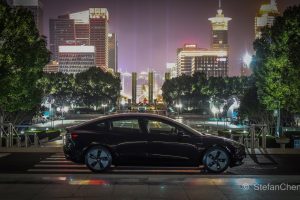- 🚗 Tesla plans to mass-produce dry electrode 4680 cells by the end of 2024.
- 🗓️ The 4680 cells were first introduced during Tesla’s Battery Day in September 2020.
- 🛠️ Dry electrode process will be used for the complete version of the 4680 battery.
- 🔋 Currently, 4680 cells in Cybertruck use a dry-process negative electrode and a wet-process positive electrode.
- 💰 Positive electrode production is the most costly part of the 4680 cells, accounting for over 35% of total cell cost.
- 🔬 Design of the dry-process positive electrode has been finalized by Tesla.
- 🚀 Mastering dry electrode processes could significantly propel Tesla’s momentum.
- 🔌 Current output of 4680 cells is sufficient for about 1,000 Cybertruck units per week.
- 🚀 Optimized dry electrode batteries may also be rolled out to other Tesla vehicles.
In the world of electric vehicles (EVs) and revolutionary battery technologies, Tesla continually makes headlines with its innovative strides. The latest buzz from the EV giant comes with a significant development as Tesla plans to mass-produce dry electrode 4680 cells by the end of 2024. This groundbreaking move was anticipated since Tesla’s Battery Day back in September 2020, and it marks another milestone in the company’s relentless pursuit of energy efficiency and cost reduction.
Tesla’s Battery Day: The Dawn of 4680 Cells
Back in September 2020, Tesla introduced the 4680 battery cells during its much-celebrated Battery Day. This innovative battery design promised to enhance performance, reduce costs, and drive the energy sector into a new era. The cylindrical 4680 cell, named for its dimensions of 46mm by 80mm, aims to deliver five times the energy capacity and six times the power of Tesla’s previous cells.
Benefits of 4680 Cells
- Increased Energy Density: The new design increases energy storage, thereby providing longer driving ranges.
- Enhanced Power Output: With greater power, EVs can achieve quicker acceleration and improved overall performance.
- Cost Reduction: Tesla aims to cut battery costs by about 50%, making electric vehicles more affordable to the average consumer.
The Dry Electrode Process: A Game-Changer
One of the most compelling aspects of the new 4680 cells is the use of dry electrode technology in their construction. This breakthrough process is not only environmentally friendly but also significantly reduces manufacturing costs and time.
Key Points About the Dry Electrode Process
- Environmental Impact: The dry process eliminates the need for toxic solvents, making it a greener alternative to traditional wet processes.
- Efficiency and Speed: The dry electrode technique can accelerate production cycles, enhancing overall manufacturing efficiency.
- Cost Reduction: By simplifying the process, Tesla can save significant amounts on production costs, which can be passed on to consumers.
Current Status and Future Potential
As of now, the 4680 cells used in Tesla’s highly anticipated Cybertruck feature a mix of dry-process negative electrodes and conventional wet-process positive electrodes. This combination still represents a significant leap forward, but the fully dry process promises even greater benefits.
Current Applications
- Cybertruck: At present, Tesla is able to produce enough 4680 cells for roughly 1,000 Cybertruck units per week. This limited output indicates that Tesla is still optimizing the production process but is on the cusp of ramping up significantly.
Technical Challenges and Solutions
Dry-process positive electrodes have proven to be the most challenging and costly part of the new 4680 batteries, accounting for over 35% of the total cell cost. However, Tesla’s recent finalization of the dry-process positive electrode design is a significant step toward overcoming these hurdles.
Addressing the Challenges
- Cost Management: Tesla must continue to innovate to bring down the high costs associated with positive electrode production.
- Scaling Production: Optimizing the output and scaling production will be crucial to meeting the end-of-2024 target for mass production.
The Bigger Picture: Tesla’s Strategic Momentum
Mastering the dry electrode technology offers Tesla unprecedented momentum in the EV market for several reasons:
Strategic Advantages
- Market Leadership: By advancing battery technology, Tesla can solidify its position as the leader in the EV industry.
- Cost Leadership: Reduced production costs can help Tesla offer more competitively priced vehicles.
- Sustainability: Environmentally friendly processes enhance Tesla’s brand reputation as a green technology leader.
Future Prospects: Beyond the Cybertruck
Once optimized, the dry electrode 4680 cells are expected to be rolled out to other Tesla vehicles, further extending the benefits across its entire range.
Potential Rollouts
- Model 3 and Model Y: Widely popular, these models could see performance boosts and cost reductions with the new battery cells.
- Semi and Roadster: Enhanced battery capacity could significantly impact the performance and efficiency of these high-demand models.
Conclusion
Tesla’s plan to mass-produce dry electrode 4680 cells by the end of 2024 marks a pivotal moment in the evolution of electric vehicle technology. By successfully implementing this technology, Tesla not only advances its own product capabilities but also sets a benchmark for the entire industry. As we look forward to the end of 2024, Tesla’s relentless innovation promises a brighter, greener, and more efficient future for electric vehicles.





